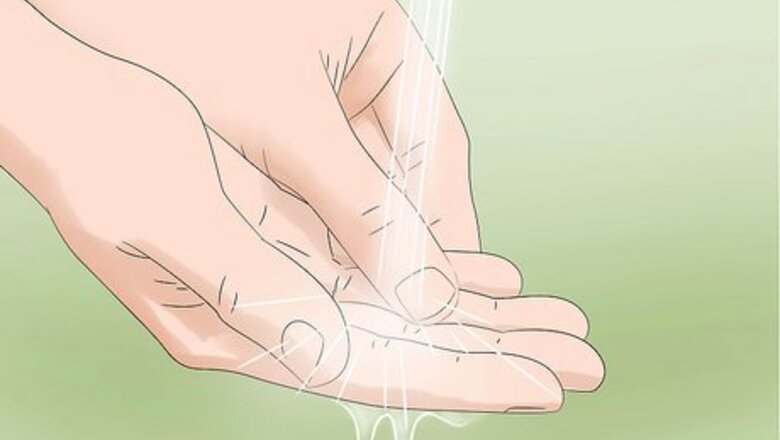
views
Handling Hooked Fish
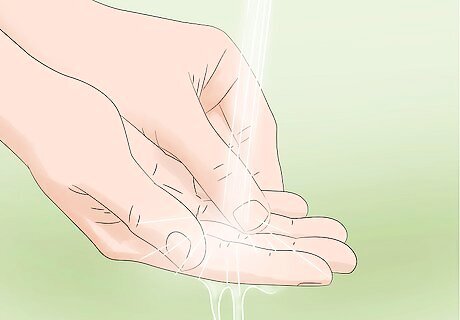
Get your hands wet before handling the fish. Most fish are coated in a moist protective layer of mucus, and too much contact can damage that layer. Keeping your hands wet while you hold the fish will help avoid damage. If you are using gloves, wet your gloves in the water before handling the fish.
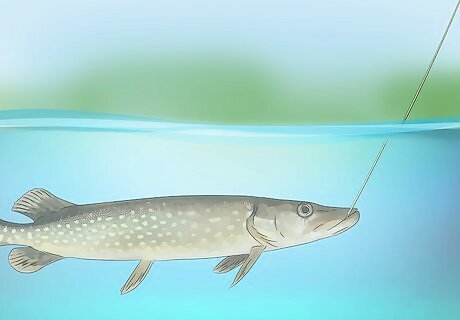
Keep the fish underwater if possible. Pulling the fish out of the water at all can stress and potentially injure it. If you plan on releasing the fish, the best bet for its survival is to keep it in the water while you unhook it. If you have to raise it above the water to unhook it, try to keep it as close to the water as possible.

Hold your breath while you have the fish out of the water. This will help you determine how long you can safely keep the fish out of the water where it can breathe. While it’s not a perfect measurement, it can be a convenient way to keep track of time and ensure that you remember to return the fish to water before it suffocates. If you don’t want to hold your breath, keep track of time and make sure the fish isn’t out of the water for more than 90 seconds.
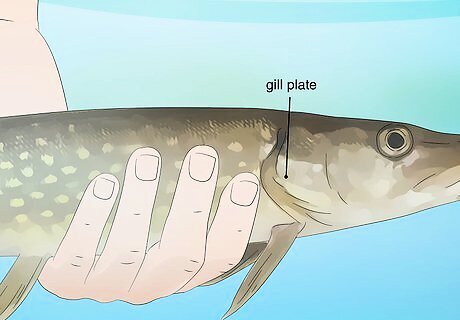
Hold the fish horizontally with your hand behind the gill plate. Placing your fingers behind the gill plate, or the flaps on either side of the fish’s head, will typically give you a secure grip. Be very careful not to touch or insert your fingers in the actual gills, which are delicate organs necessary for the fish’s survival. Smaller fish, such as crappie, bluegill, or tilapia, can usually be held with one hand.

Support larger fish with both hands. If the fish is big enough that it can be held with 2 hands, it’s best to do so. This will keep the weight of the fish from damaging its bones or internal organs. Holding a large fish with 1 hand can put dangerous amounts of pressure on its jaw or gill plate. Keep 1 hand behind the gill plate and the other under its belly. Most largemouth bass, catfish, and carp are best held with both hands.
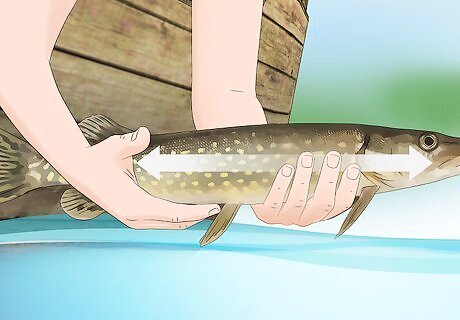
Keep the fish’s body in a straight horizontal line. It is very important to keep the fish’s body straight to avoid bending its jaw or spine at an unnatural angle. For this reason, it is best not to move the fish around too much when handling it. It’s also considered safer to keep the fish horizontal, since a vertical position is unnatural for most fish and could cause damage to internal organs. The fish’s body should not be at more than a 10° angle to its head at any time.
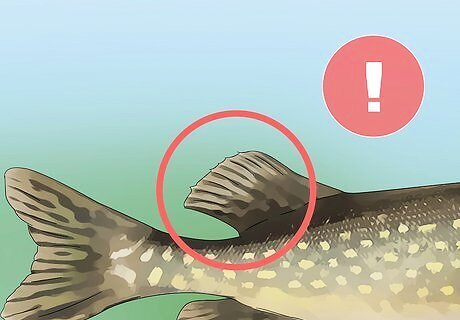
Avoid touching the sharp edges of the dorsal fins. Many fish have dorsal fins, or fins on their backs, that can cut into your hand if you’re not prepared. If you are holding a small fish with 1 hand, slide your hand from the front of the fish to the back to smooth the dorsal fin down under your palm so that you can safely grip the sides of the fish.
Releasing Fish after a Catch
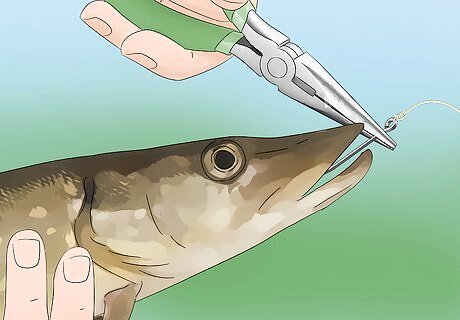
Use pliers to remove the hook. This is generally safer for you if the fish has teeth, and can often be more precise and efficient than doing it by hand. Use long-handled fishing pliers or forceps to handle the hook. You can either cut the barb off with a wire cutter or flatten the barb with your pliers. Hold the hook by where it connects to the line, then carefully rotate it so that the end of the hook comes out. If you are dealing with a large fish and don’t have anyone to help you, sit down and support the fish’s body on your knees while you use 1 hand to remove the hook.
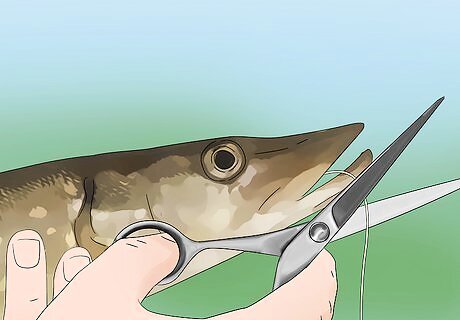
Cut the line on hooks that have been swallowed deep. Rather than attempt to remove hooks that are deep in the fish’s throat, cut the line and release the fish without removing the hook. This will most likely cause less damage to the fish. Even if it means losing a hook, you will be doing the local ecosystem a favor.
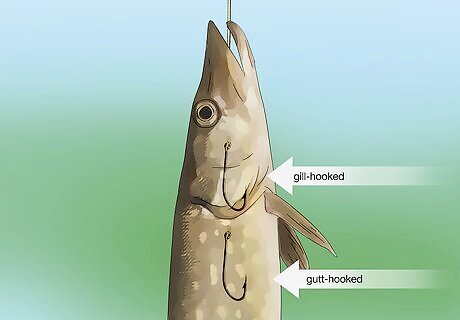
Choose gut-hooked or gill-hooked fish when taking fish home. If you plan to release some fish and catch others, the most humane option is to keep the fish that have hooks sunk deep down their throats or have been hooked through a gill. Even if the line is cut, these fish will very likely suffer injuries that may lead to infection and death. Keeping these fish rather than those with a higher chance of survival will be better for the fish and for the water. You can help avoid gut-hooking fish by reeling them in quickly once they bite. The longer the fish have to struggle after being hooked, the likelier they are to swallow your hook, which will make removing the hook more difficult. Refrain from using baits and artificial scents, which can also cause fish to swallow hooks.

Move away from fast currents before releasing the fish. If you are in very fast-moving water, you may want to move toward slower currents to give the fish a better chance at resuscitating once you release it. However, if slower waters will take several minutes to reach, the fish will be better off getting into the water sooner rather than later.
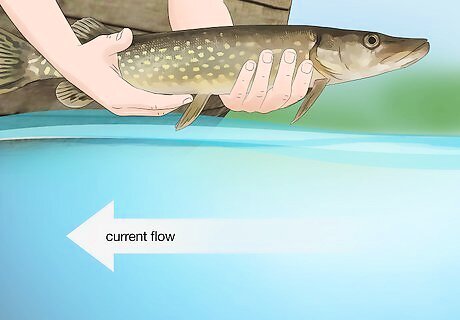
Place the fish in the water facing the current. This is especially important if the fish has been out of the water for several minutes or seems stunned or non-responsive. Facing it towards the current will give it a rush of oxygenated water that may help revive it.
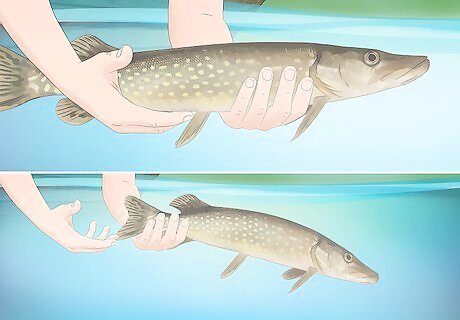
Hold on to the fish in the water until it swims away. The fish may need a few moments to re-acclimate to the water, and letting go before it’s ready may be harmful. Hold it by the sides or the gill plate until it starts to swim away on its own.




















Comments
0 comment